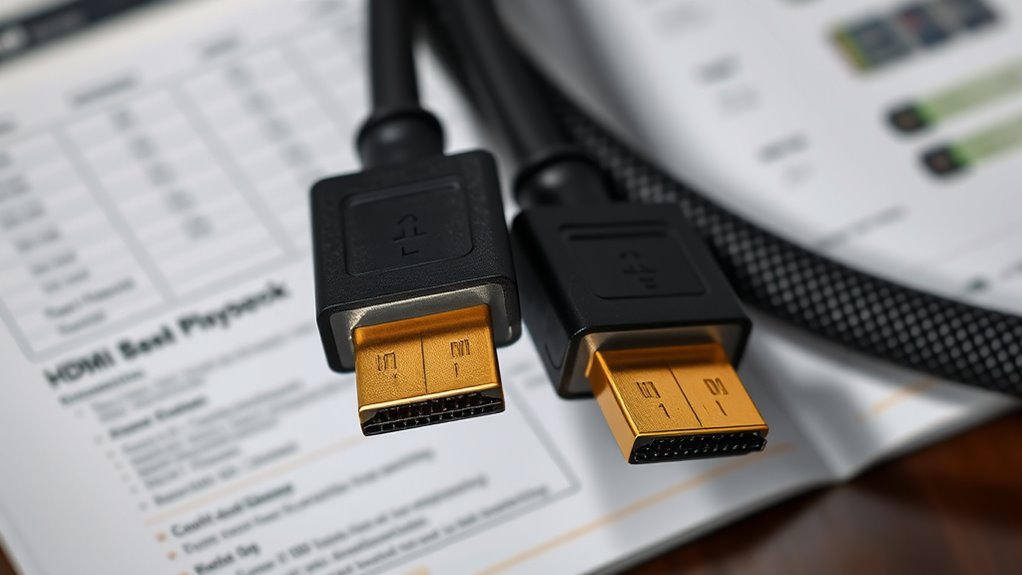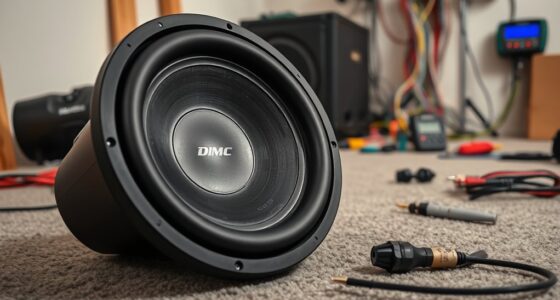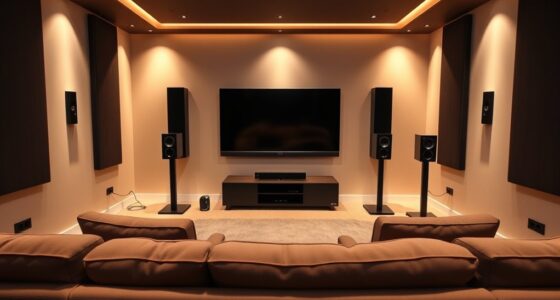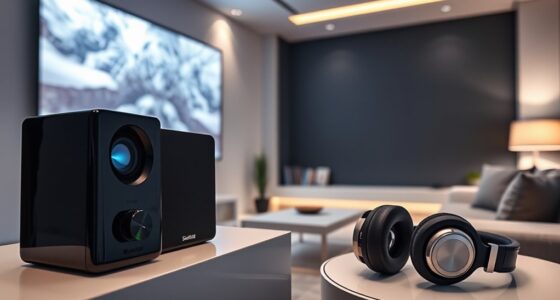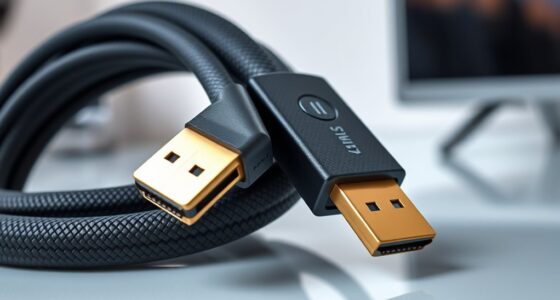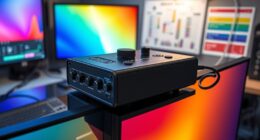HDMI 2.1 cables support higher resolutions, faster refresh rates, and richer audio, backed by strict compliance standards. Certification guarantees your cables meet safety and performance benchmarks, helping you avoid counterfeit products. Look for clear branding, labels, and coding systems that verify authenticity. Understanding these codes and markings helps ensure compatibility and reliable performance. If you want to learn how to identify, verify, and get the most from HDMI 2.1 cables, there’s more to explore ahead.
Key Takeaways
- HDMI 2.1 cables feature certification marks, compliance standards, and detailed labeling to verify authenticity and performance.
- High-quality cables use coding systems like color codes and markings to distinguish Ultra High-Speed from standard versions.
- Proper shielding and industry compliance ensure signal integrity, reduce interference, and support high-bandwidth features like 8K at 48 Gbps.
- Authenticity can be confirmed through packaging details, holograms, serial numbers, and reputable sources.
- Certification by HDMI Licensing ensures cables meet safety, performance, and interoperability standards, preventing counterfeit products.
Understanding HDMI 2.1: Key Features and Benefits

HDMI 2.1 introduces significant improvements that enhance your viewing and gaming experiences. One key feature is increased HDMI bandwidth, allowing for higher data transfer rates that support higher resolutions and refresh rates. This means you can enjoy 4K at 120Hz or even 8K content smoothly. Additionally, HDMI 2.1 boosts HDMI color depth, delivering richer, more vibrant colors with greater detail and realism. With these enhancements, your devices can handle more advanced graphics and immersive visuals without sacrificing quality. The increased bandwidth also enables features like dynamic HDR, optimizing picture quality scene-by-scene. Overall, HDMI 2.1 elevates your entertainment setup, providing sharper images, smoother gameplay, and a more immersive viewing experience.
Decoding HDMI 2.1 Technical Specifications
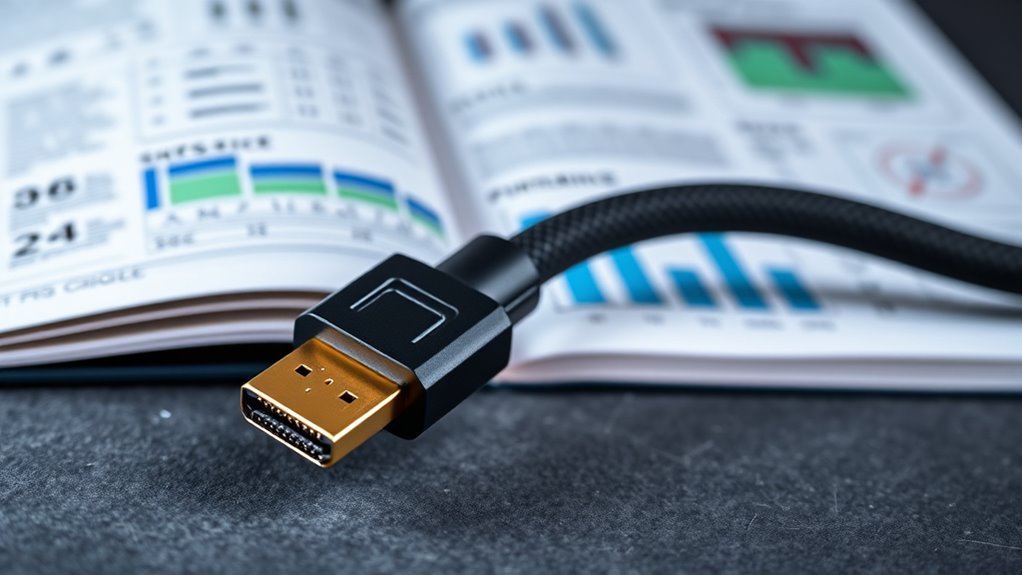
To fully grasp the benefits of HDMI 2.1, it helps to understand its technical specifications. These specs determine performance, durability, and ease of use. First, the bandwidth reaches up to 48 Gbps, supporting higher resolutions and refresh rates. Second, cable durability is vital, ensuring the cable withstands frequent plugging and unplugging without damage. Third, an ergonomic design enhances handling, making the cable easier to connect securely. Key features include Dynamic HDR, Enhanced Audio Return Channel (eARC), and variable refresh rate support—each contributing to a better viewing experience. Knowing these specs helps you choose cables that not only maximize performance but are also built for long-term use. Color accuracy and reliable specifications ensure your setup remains seamless and effective.
The Role of Compliance in HDMI 2.1 Cables
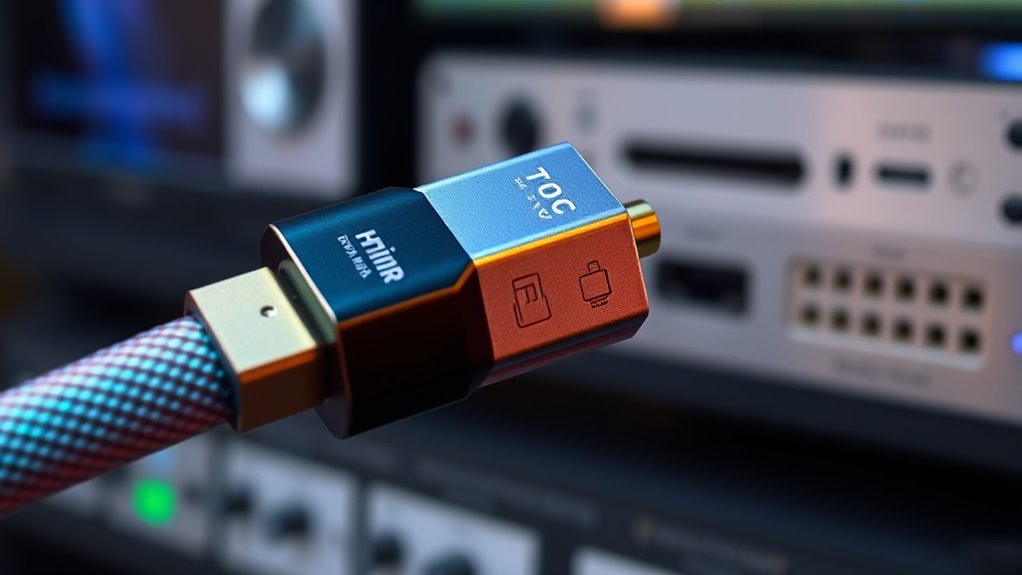
When choosing HDMI 2.1 cables, compliance guarantees your signal stays clear and reliable. It also guarantees that the cable meets industry standards for performance and safety. By paying attention to compliance, you can avoid compatibility issues and get the most out of your devices. Additionally, understanding industry standards ensures you select cables that support the full capabilities of HDMI 2.1 technology.
Ensuring Signal Integrity
Ensuring signal integrity in HDMI 2.1 cables hinges on strict compliance with industry standards. When cables meet these standards, they minimize signal degradation and effectively combat interference. To understand how, consider these key factors: 1. Proper shielding reduces electromagnetic interference, keeping signals clear. 2. High-quality connectors ensure tight, reliable connections that prevent data loss. 3. Use of premium materials and precise manufacturing techniques help maintain consistent signal strength over longer distances. Additionally, HEPA filtration in related technologies illustrates the importance of adhering to rigorous standards to ensure optimal performance and reliability.
Adherence to Industry Standards
Adherence to industry standards is essential for HDMI 2.1 cables to perform reliably and deliver ideal signal quality. When cables meet strict compliance guidelines, you can trust their ability to handle high bandwidths and advanced features like 8K video and enhanced audio. Standards also influence cable aesthetics, ensuring a consistent, professional look that complements your setup. Proper compliance often reflects in packaging design, which clearly indicates certifications and guarantees quality. This not only helps you identify genuine, high-quality cables but also prevents compatibility issues. By choosing cables that follow established standards, you reduce risks of signal degradation, interference, and potential damage. Ultimately, strict adherence to industry standards ensures your HDMI 2.1 cable performs at its best, providing a seamless, high-quality entertainment experience.
HDMI Licensing and Certification Standards
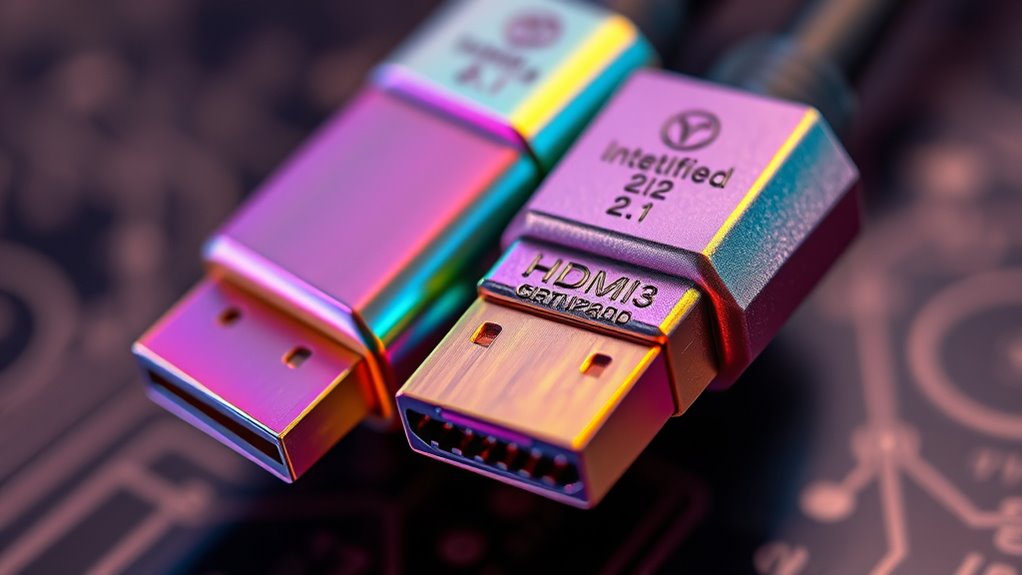
Understanding HDMI licensing and certification standards is key to knowing what guarantees your cables meet quality and performance benchmarks. You’ll want to recognize the role of licensing authorities in setting these requirements. This helps you make informed decisions when choosing certified HDMI 2.1 cables for your setup. Implementing fraud detection techniques can also ensure the authenticity and security of your transactions, further safeguarding your investments.
Certification Requirements Overview
To meet HDMI 2.1 standards, manufacturers must pass a series of rigorous certification processes established by the HDMI Licensing Administrator. These steps assure your cables meet performance and safety criteria. First, they verify compliance with specified cable color codes, which help identify proper wiring and quality standards. Second, they inspect packaging labeling to confirm all required information, like certification marks and specifications, is clear and accurate. Third, they conduct detailed testing to validate signal integrity, bandwidth, and compatibility with HDMI 2.1 features. These processes guarantee your cable’s authenticity and reliability. Certification ensures your product meets strict standards, giving you confidence in performance and safety. It also helps prevent counterfeit cables from entering the market, protecting your investments. Additionally, understanding risk management is essential for maintaining compliance and safeguarding your products from potential vulnerabilities.
Licensing Authority Roles
The process of certifying HDMI 2.1 cables is overseen by the HDMI Licensing Administrator, the organization responsible for maintaining and enforcing the standards. As a licensing authority, they guarantee that manufacturers adhere to compliance enforcement protocols, which helps maintain product quality and interoperability. Their licensing authority oversight involves reviewing product designs and testing samples to verify compliance with HDMI specifications. They also manage the licensing process, issuing certification marks to approved products and helping prevent counterfeit or substandard cables from entering the market. This role is vital in safeguarding consumers and ensuring reliable performance. By enforcing strict standards, the licensing authority maintains the integrity of the HDMI ecosystem, giving you confidence that certified HDMI 2.1 cables meet all necessary technical and safety requirements. Additionally, the licensing authority plays a crucial role in creative practice by fostering innovation and ensuring that new technologies integrate seamlessly into existing standards.
Identifying Authentic HDMI 2.1 Cables

How can you tell if an HDMI 2.1 cable is genuine? Start by examining the cable branding; authentic cables usually have clear, consistent branding stamped or printed on the cable itself. Next, check the packaging labels—reliable manufacturers include detailed specifications, HDMI licensing logos, and certification marks that confirm compliance. Finally, verify the packaging labels for authenticity: look for high-quality printing, holograms, or security seals, which indicate a legitimate product. Be cautious of cheap-looking packaging or missing information, as these often signal counterfeit cables. Genuine HDMI 2.1 cables adhere to strict guidelines, ensuring you’re getting quality and performance. Always buy from reputable sources and scrutinize packaging labels and cable branding for peace of mind. Additionally, ensure the cable supports the durability and high-quality materials required for optimal performance and longevity.
Common Coding Systems and Markings on HDMI Cables
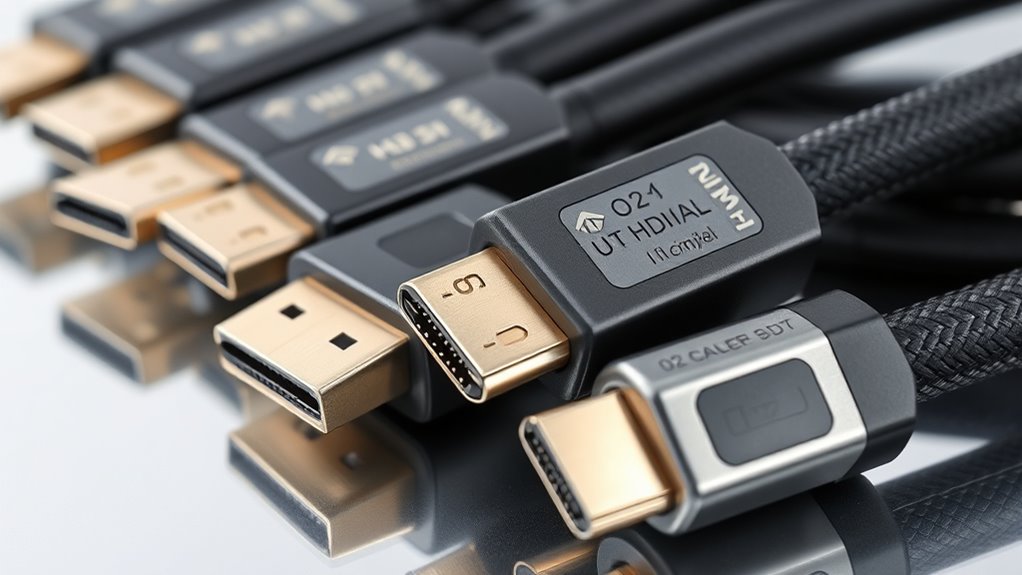
Authentic HDMI 2.1 cables often feature specific coding systems and markings that help verify their authenticity and capabilities. One common method is the use of cable color codes, which can indicate the cable’s specifications or certification level. For example, certain colors on the connector or cable sheath may denote high-speed or ultra-high-speed ratings. Additionally, packaging labels provide vital information, such as compliance standards, HDMI version, and bandwidth support. These labels often include certification logos, serial numbers, and compliance codes, making it easier for you to confirm the cable’s quality and origin. Paying attention to these markings guarantees you’re investing in a genuine HDMI 2.1 cable that meets the necessary standards for peak performance. Being aware of cable coding systems can further assist in distinguishing authentic cables from counterfeit ones.
Compatibility Considerations With HDMI 2.1 Devices

Ensuring compatibility between HDMI 2.1 cables and devices is essential for achieving peak performance. To do so, you must consider device compatibility and setup considerations carefully. First, verify that your source device, display, and cables support HDMI 2.1 standards. Second, check for the correct version of HDMI ports on all devices, ensuring they’re compatible. Third, pay attention to bandwidth requirements, making sure your devices can handle the higher data transfer rates and features like eARC and VRR. These setup considerations help prevent issues like signal loss or limited features. By confirming compatibility across all components, you’ll maximize your HDMI 2.1 experience, ensuring seamless performance and future-proofing your setup for the latest technologies. Additionally, understanding device tuning can help optimize performance and resolve potential issues with high-bandwidth connections.
Troubleshooting HDMI 2.1 Connection and Performance Issues
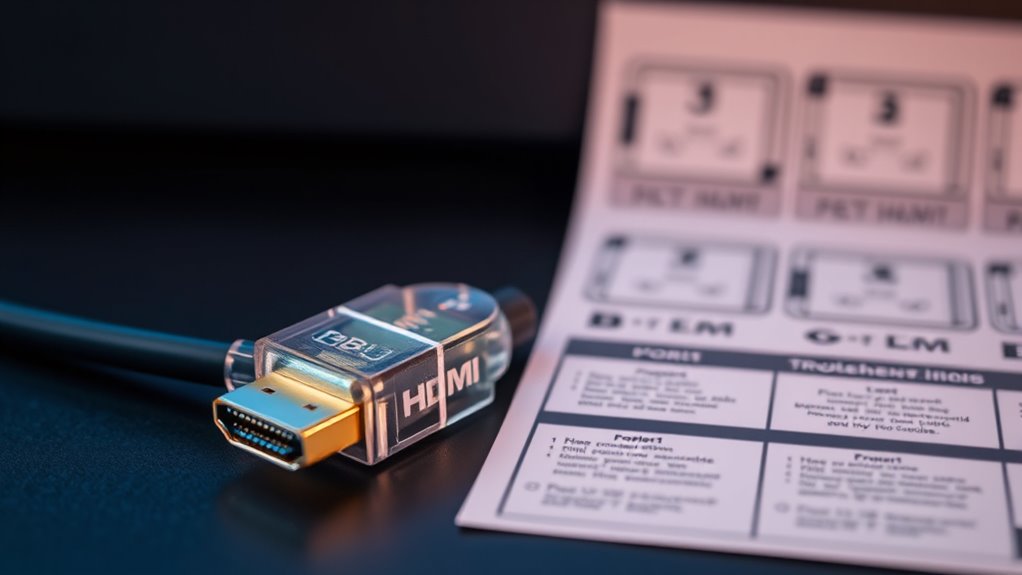
When experiencing issues with your HDMI 2.1 connection, troubleshooting begins with checking the physical setup. Confirm your cables are securely plugged in and free of damage. Signal interference from nearby electronic devices can disrupt data transmission, so move potential sources away from your HDMI cables. Pay attention to cable length, as longer cables may weaken signals and cause flickering or no picture. Using cables that exceed recommended lengths without proper signal boosters can lead to performance issues. Test your setup with shorter cables if problems persist. Additionally, verify that all devices support HDMI 2.1 features and are updated with the latest firmware. By addressing physical connections, minimizing interference, and managing cable length, you can resolve most common HDMI 2.1 performance problems. Ensuring that your setup complies with technology standards can also help minimize compatibility issues and optimize performance.
Future Trends and Innovations in HDMI 2.1 Technology
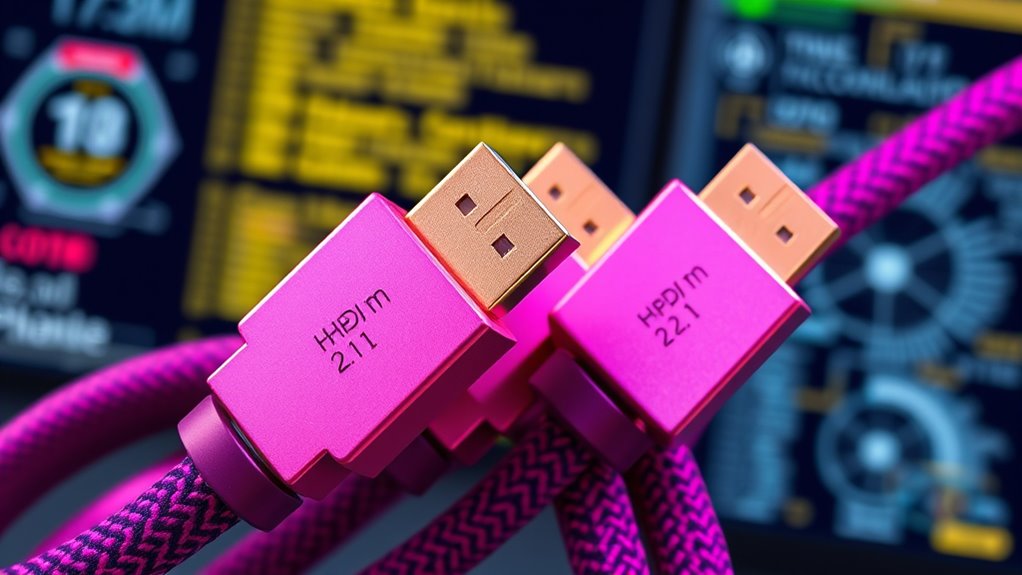
As HDMI 2.1 continues to evolve, future innovations promise even higher data transfer speeds, enhanced video and audio quality, and smarter connectivity options. You can expect more seamless integration with smart home devices, making control and automation more intuitive. Virtual reality will benefit from faster, more stable connections, reducing lag and improving immersion.
Some upcoming trends include:
- Increased bandwidth for 8K and higher resolutions, supporting richer visuals.
- Advanced eARC features for superior audio experiences across multiple devices.
- Embedded encryption and security measures to safeguard your smart home network.
These advancements will make your entertainment systems more immersive, connected, and secure, pushing HDMI 2.1 to new heights.
Frequently Asked Questions
How Do I Verify HDMI 2.1 Cable Authenticity at Purchase?
To verify HDMI 2.1 cable authenticity at purchase, check for cable certification labels or logos from reputable organizations like HDMI Licensing. Look for official packaging that mentions HDMI 2.1 compliance and ascertain it matches the product description. You can also verify authenticity by inspecting the build quality and connectors. Avoid unbranded or suspiciously cheap cables, as they often lack proper certification and may not support the full HDMI 2.1 features.
What Are Common Signs of Incompatible HDMI 2.1 Cables?
If your HDMI 2.1 cable causes signal disruptions or compatibility issues, beware—these are common signs it’s incompatible. You might notice flickering screens, no picture or sound, or devices that won’t connect. Don’t ignore these signs; they often mean the cable isn’t up to spec. Always verify the cable’s specifications and certification to guarantee it meets HDMI 2.1 standards, preventing frustration and maximizing your setup’s performance.
Can HDMI 2.1 Cables Be Backward Compatible With Older Devices?
Yes, HDMI 2.1 cables are generally backward compatible with older devices. Compatibility considerations mean you can connect an HDMI 2.1 cable to devices with earlier HDMI versions, but cable performance may be limited by the older device’s capabilities. To guarantee peak performance, check device specifications and use certified cables, especially if you want to enjoy higher resolutions or faster refresh rates supported by HDMI 2.1.
How Do Coding Standards Differ Between HDMI 2.1 and Previous Versions?
You might wonder how HDMI 2.1’s coding standards differ from earlier versions. They introduce advanced digital signal standards that handle higher bandwidths, making ultra HD and dynamic HDR possible. Meanwhile, cable manufacturing protocols have evolved, emphasizing stricter compliance and enhanced quality controls. This guarantees your devices communicate flawlessly, enabling new levels of performance. The leap isn’t just in speed but in the very way signals are encoded and transmitted.
Are There Specific Branding or Logos Indicating HDMI 2.1 Compliance?
Yes, HDMI 2.1 cables often feature distinct branding symbols or logos, usually placed on the packaging or cable itself, indicating compliance. Look for the HDMI logo accompanied by “HDMI 2.1” or specific certification marks like Ultra High Speed. These logos help you quickly identify cables that meet the latest standards, ensuring peak performance for high-bandwidth features like 4K, 8K, and enhanced gaming experiences.
Conclusion
Understanding HDMI 2.1 cables isn’t just about checking labels—it’s about ensuring genuine quality and compatibility. Many believe all high-speed cables are equal, but certifications and markings reveal true performance capabilities. By verifying compliance and coding, you can avoid issues and access the full potential of your devices. Trusting certified cables proves that adhering to standards truly makes a difference, confirming that quality and compatibility go hand in hand for ideal home entertainment.
